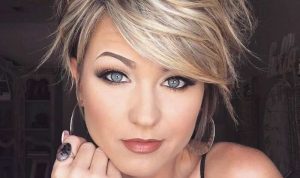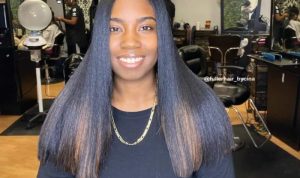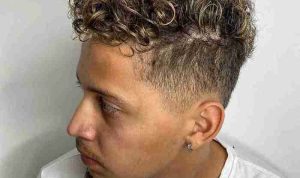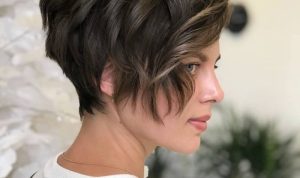Understanding Thin Hair Textures
Thin hair hairstyles female – Thin hair can manifest in several ways, impacting styling options and requiring tailored approaches. Understanding the nuances of thin hair textures is crucial for choosing the right hairstyles and products.
Types of Thin Hair
Thin hair isn’t a monolithic category. It encompasses three main types: fine, thin, and sparse. Fine hair refers to the individual strands’ diameter; fine hair has a small diameter, making it appear less dense. Thin hair, on the other hand, describes the overall density of hair on the scalp; there are fewer strands overall. Sparse hair is a more severe form of thin hair, characterized by significantly reduced hair density, often resulting from medical conditions or hair loss.
Causes of Thin Hair in Women
Several factors contribute to thin hair in women. Genetics play a significant role, with some women inheriting a predisposition to thinner hair. Hormonal changes, particularly during pregnancy, menopause, or due to hormonal imbalances, can also lead to hair thinning. Nutritional deficiencies, particularly in protein and iron, can impact hair health and growth. Stress, illness, and certain medical treatments (like chemotherapy) can also cause temporary or permanent hair loss.
Furthermore, harsh hair styling practices, such as excessive heat styling and tight hairstyles, can damage hair and contribute to thinning.
Impact of Hair Porosity on Styling
Hair porosity refers to the hair cuticle’s ability to absorb and retain moisture. High porosity hair, with raised cuticles, absorbs moisture quickly but also loses it rapidly. This makes styling challenging, as products may not adhere well. Low porosity hair, with tightly closed cuticles, struggles to absorb moisture, requiring specific products and techniques. Understanding your hair’s porosity is essential to selecting suitable styling products and techniques that will enhance the volume and manageability of thin hair.
For instance, individuals with high porosity hair may benefit from lightweight, moisturizing products, while those with low porosity hair may require products that penetrate the hair shaft more effectively.
Hairstyle Categories for Thin Hair: Thin Hair Hairstyles Female
Choosing the right hairstyle can significantly impact the appearance of thin hair. Consider hair length, face shape, and styling techniques to maximize volume and create a flattering look.
Hairstyles by Hair Length
- Short Hairstyles: Pixie cuts, short bobs, and layered crops create the illusion of thickness by adding texture and movement. These styles are easy to manage and require minimal styling.
- Medium Hairstyles: Lob (long bob), shoulder-length layered cuts, and wavy styles offer versatility and can be styled in various ways to create volume.
- Long Hairstyles: Long layered hairstyles, particularly those with face-framing layers, can create movement and prevent the hair from appearing flat. However, proper styling and lightweight products are essential to avoid weighing down the hair.
Hairstyles by Face Shape
- Round Faces: Long layers, side parts, and hairstyles with height on top can elongate the face.
- Oval Faces: Most hairstyles suit oval faces, but layers and volume around the crown can add dimension.
- Square Faces: Soft layers, side-swept bangs, and styles that add volume around the temples can soften the jawline.
- Heart Faces: Styles that add volume at the bottom, such as a chin-length bob or layers that start below the cheekbones, balance the wider forehead.
- Diamond Faces: Styles that add volume to the sides, such as a side-swept bang or a layered bob, balance the narrow chin and wide cheekbones.
Hairstyle Recommendations
| Hairstyle Name | Description | Best Face Shape | Hair Length |
|---|---|---|---|
| Pixie Cut | Short, cropped style with layered texture. | Oval, Heart | Short |
| Layered Bob | Shoulder-length bob with varying lengths for volume. | Oval, Square, Diamond | Medium |
| Long Layered Hairstyle | Long hair with layers to add movement and prevent flatness. | Oval | Long |
| A-Line Bob | Bob that is shorter in the back and longer in the front, adding volume and shape. | Round, Heart | Medium |
Styling Techniques to Add Volume
Several styling techniques can enhance the appearance of thin hair, creating the illusion of thickness and fullness.
Volumizing Products
Volumizing mousses, sprays, and serums are designed to add body and lift to thin hair. Mousses provide a light hold and lift at the roots. Volumizing sprays offer a finer mist for added texture and volume. Serums, often silicone-based, coat the hair to create the appearance of thicker strands. It is crucial to choose products that are lightweight to avoid weighing down the hair.
Blow-Drying Techniques
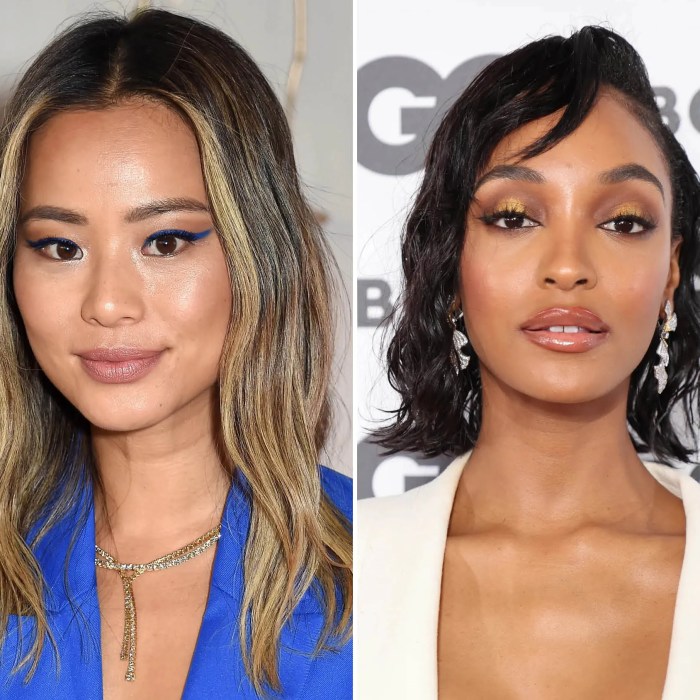
Source: allure.com
Proper blow-drying techniques are essential for adding volume. Start with a volumizing product applied to damp hair. Use a round brush to lift the hair at the roots as you dry, directing the airflow upwards. Consider using a nozzle attachment to focus the airflow and avoid dispersing the volume. Allowing hair to air-dry partially before blow-drying can also help create more volume.
Using Curling Irons and Straighteners
Curling irons and straighteners can be used strategically to add volume to thin hair. For curling irons, focus on the mid-lengths and ends, leaving the roots relatively straight to create lift. When using straighteners, create subtle bends or waves rather than perfectly straight hair to avoid a flat look. Remember to use heat protectant spray before applying any heat styling tool to minimize damage.
Hairstyles that Create the Illusion of Thickness
Specific haircuts and styling choices can cleverly create the illusion of thicker hair.
Layered Haircuts
Layered haircuts are excellent for adding volume and dimension to thin hair. The varying lengths of the layers create texture and movement, preventing the hair from looking flat and lifeless. Consider layers that are shorter around the crown to create lift and volume at the roots.
Benefits of Bangs and Fringe
Bangs and fringe can add fullness to the front of the hair, creating a more balanced and voluminous look. Side-swept bangs are particularly effective for framing the face and adding body. Blunt bangs can also work well, but require more precise styling and may not be suitable for all hair types and face shapes.
Finding the right hairstyle can be a challenge with thin hair, but there are many stylish options available. If you’re considering a shorter look, exploring hairstyles for short thin hair female can be a great starting point. Ultimately, the best hairstyle for thin hair depends on individual preferences and facial features, but short cuts often add volume and manageability.
Layered Bob Hairstyle
A layered bob, particularly an A-line bob, is a highly effective hairstyle for thin hair. The shorter layers at the back add volume and lift, while the longer layers in the front create a flattering frame for the face. This style can be styled straight or wavy, offering versatility and enhancing the appearance of thicker hair. The varying lengths of the layers create movement and texture, preventing the hair from looking flat or lifeless.
Updos and Braids for Thin Hair
Updos and braids can be challenging with thin hair, but with the right techniques, they can be stylish and manageable.
Easy Updos
Loose, low buns, messy chignons, and half-updos are more forgiving on thin hair than tight, sleek styles. Using bobby pins strategically to secure the style and adding a texturizing product beforehand can help create more volume and hold.
Braiding Techniques
Loose braids, such as fishtail braids or French braids, are suitable for thin hair. Avoid tight braids that can pull on the hair and exacerbate thinning. Adding extensions or incorporating small amounts of hair from adjacent sections can create a fuller braid.
Challenges and Solutions
Thin hair can be difficult to hold in updos and braids. Using texturizing sprays or mousses can add grip and prevent slippage. Bobby pins and hair ties should be chosen carefully to avoid damaging the hair. If the hair is too fine to hold the style, consider using volumizing products or adding hair extensions for added volume and grip.
Hair Accessories and Thin Hair
Hair accessories can be used to enhance thin hair styles and create the illusion of thickness.
Examples of Hair Accessories
Headbands can add a touch of style and disguise a less-than-perfect hairstyle. Clips can be used to lift and secure sections of hair, creating volume. Scarves can be wrapped around the head to add texture and visual interest.
Using Hair Extensions
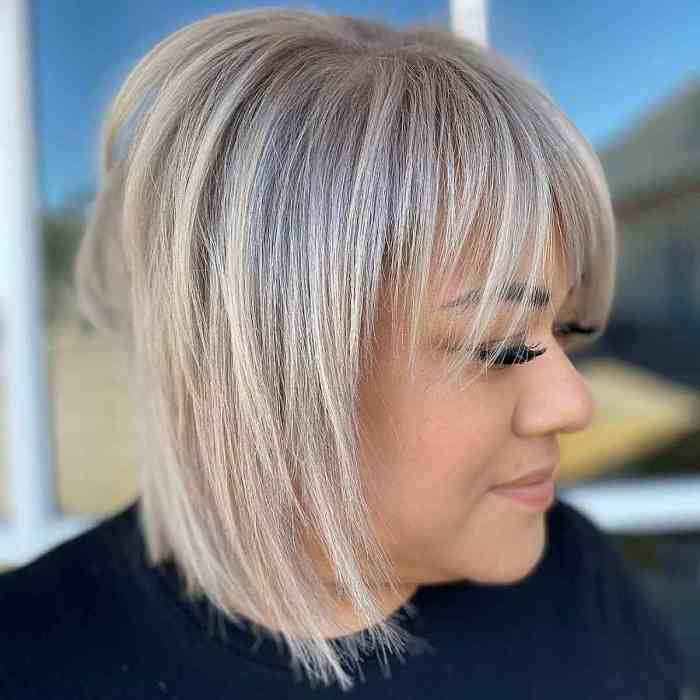
Source: latest-hairstyles.com
Hair extensions are a great way to add volume and length to thin hair. They can be used for special occasions or worn regularly to enhance the appearance of thicker hair.
Types of Hair Extensions
Clip-in extensions are temporary and easy to apply, making them ideal for occasional use. Tape-in extensions are semi-permanent and offer a more natural look. Sew-in extensions are more permanent and require professional installation. The choice depends on budget, desired longevity, and comfort level.
Maintaining Healthy Thin Hair
A dedicated hair care routine is essential for maintaining the health and appearance of thin hair.
Hair Care Routine
Wash hair with a gentle, volumizing shampoo and conditioner. Avoid harsh sulfates and silicones that can strip the hair of its natural oils. Use a wide-tooth comb to detangle wet hair gently to minimize breakage. Condition regularly to maintain moisture and prevent dryness.
Healthy Diet and Lifestyle
A balanced diet rich in protein, iron, and vitamins is crucial for healthy hair growth. Stress management techniques, such as exercise, yoga, or meditation, can also contribute to healthier hair.
Products to Avoid
Heavy styling products, such as heavy oils and creams, can weigh down thin hair, making it appear even thinner. Sulfates and silicones can strip the hair of its natural oils, leading to dryness and breakage. Choose lightweight, volumizing products instead.
Illustrative Examples of Hairstyles
Pixie Cut Hairstyle, Thin hair hairstyles female
A pixie cut is a short, cropped hairstyle that is versatile and can suit various face shapes and hair textures. Its short length minimizes the appearance of thinness, while strategic layering can add texture and movement. The style is easy to maintain and can be styled in various ways, from sleek and polished to messy and textured. For round faces, a pixie cut with longer layers at the front can help to elongate the face.
For oval faces, almost any pixie cut variation works well.
Long Layered Hairstyle
A long layered hairstyle can create the illusion of thickness by adding movement and preventing the hair from looking flat. Long layers starting at the chin or below can add body and bounce. Face-framing layers can further enhance the style and create a more balanced look. To maximize volume, use volumizing products at the roots and style the hair with a round brush to lift the layers.
Side-Swept Bang Hairstyle
Side-swept bangs are a great way to add volume and frame the face. The sweeping motion of the bangs creates a sense of movement and draws attention away from areas of thinness. The bangs can be styled straight or wavy, depending on the overall look. They can soften harsh features and create a more balanced and youthful appearance.
FAQ
Can I use dry shampoo on thin hair?
Yes, but use sparingly to avoid build-up, which can make hair look even thinner. Focus on the roots and use a lightweight formula.
How often should I wash my thin hair?
Every other day or every two days is generally recommended to avoid stripping natural oils, which can lead to dryness and breakage. Adjust based on your hair’s individual needs.
Are there specific vitamins that promote hair growth?
Biotin, vitamin D, and iron are often cited for their potential benefits to hair growth. Consult a doctor or nutritionist to determine if supplementation is necessary for you.
What’s the best way to prevent hair breakage?
Use gentle hair care products, avoid harsh brushing or combing, and minimize heat styling. Regular trims remove split ends and prevent further damage.


